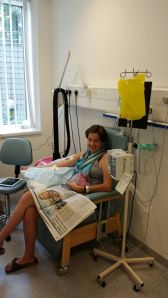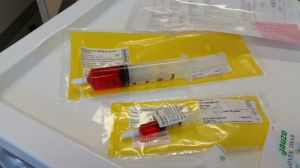

So since I started getting my chemotherapy many people have asked what chemo actually is. For me it has now become horribly mundane but I realise that for most people it is still a bit of a mystery so I thought I would do a little post about the chemo experience.
It is really important that people know that chemotherapy is not as bad as it sounds. One of the reasons that my cancer was so advanced when it was diagnosed was that I had been petrified of going to the doctor and left it to develop. Part of the fear of the doctor was connected to a fear about the treatment. I can honestly say that although chemotherapy is undoubtedly not great, it has not been terrifying. The medical staff are so great and work really hard to ensure that the experience is as pleasant as possible. Since I have been diagnosed the most stressful thing that I have gone through has not been the treatment but instead my PET scans but that is not because of the cancer but instead because I am claustrophobic and so not a great fan of being put into confined spaces.
In essence to get chemotherapy, take one PICC line, hook it onto various intravenous (IV) drugs, sit and let IV into system over many hours, go home and lie on sofa until you feel better, and then repeat. Although in reality it is a little more complex than that.
To begin with I was on a treatment called ABVD http://www.macmillan.org.uk/Cancerinformation/Cancertreatment/Treatmenttypes/Chemotherapy/Combinationregimen/ABVD.aspx This is (to the best of my knowledge) the most common chemotherapy used to treat Hodgkin’s Lymphoma. It is made up of 4 drugs; the A doxorubicin (Adriamycin), the B (bleomycin), the V (vinblastine), and the D (dacarbazine). These drugs come in 4 separate IV packets. Some of them are big IV bags, some of theme are small IV bags and the doxorubicin comes in a ‘comedy’ red syringe.
While I was on ABVD, once every 14 days I would head into the ‘chemo farm’ at my hospital. The ‘chemo farm’ is a strange place, it looks a bit like a hair salon as there are lots of chairs placed about the room but instead of people getting their hair cut, people are receiving treatments. Guests are limited to one per patient, I guess to prevent the whole of Portsmouth descending upon the treatment space.
Anyway once at the ‘chemo farm’, a nurse would then come over and start hooking things into my line to administer treatment. Before and after receiving the drugs you have to have what is known as a saline flush. This basically means that they put salt water intravenously into your system through the line. The purpose of the saline flush is to clear the PICC line of any of the chemotherapy. The line needs to be cleared of chemotherapy as the drugs are basically poison and it is not good to have them sitting in your line. One of the drugs I receive has advice printed on it that states ‘for IV use only, any other method of administration would be fatal’. A nice reminder that these drugs are fairly strong stuff! The whole treatment would take about 4 hours and after that I would head home to lie on the sofa and let the drugs do their thing.
Receiving chemotherapy is a very peculiar experience. It is not, however, a stressful experience. I have always had a chemo companion and I sit and eat, drink, read, and try to be as merry as possible as the chemo drugs go in. You can feel the drugs as soon as they enter your system. They spread around your body with a creeping, painful sensation. The pain is not acute but you are definitely aware of the drugs. They also immediately destroy your energy levels. It is like someone has pulled the energy plug and you have to retreat to the sofa and just relax.
After 4 cycles of ABVD I had a PET Scan to assess how the treatment was working. My lovely and fantastic (in fact I cannot state enough how great she is) consultant Ann was very pleased with my progress but there was still one nasty patch of live cancer evident under my left arm pit. I think she could hardly believe how well I had done considering in mid July (at the point of the first PET scan) I had the cancer all around my body. Regardless of the progress however, the fact that I still had one patch of live cancer cells meant that we decided to change my treatment to a new treatment called BEACOPP.
BEACOPP is unfortunately a bit like ABVD plus. http://www.cancerresearchuk.org/about-cancer/cancers-in-general/treatment/cancer-drugs/beacopp. In essence they keep all of the drugs that I had been receiving with ABVD and then just add some more. This means it is more intense in both the effects and the time involved. The first thing I said to Ann was ‘I’m mainly sad because I think this means chemo is going to cut more into my social life’. I was wrong about that however as it just means I have made more friends at the hospital and I really enjoy taking a chemo buddy in and having the chance to chill with them 1:1 – even if it is in the ‘chemo farm’!
What BEACOPP does mean is that I am now starting to lose my hair (further post to follow) and all of the Corney babies are likely to be cooked but really there are now so many other options and it will just be another hurdle to cross when the time comes. For now the only priority is to get me better and BEACOPP (fingers crossed, touch wood etc.) should hopefully be able to do that.
In terms of timetable, I now have 4 hospital days in week 1 of my cycle and then 2 hospital days in week 2 of my cycle. I see my consultant Ann every Tuesday at 5pm and then Wednesday, Thursday, Friday of week 1 and Wednesday of Week 2 are chemo days. This is all quite an increase on the 2 hospital days per 2 week cycle that I was previously experiencing with ABVD!
The number of oral pills has also increased and on top of this I have to have an injection every day of the second week of my cycle. The purpose of the injection is to stimulate my bone marrow into producing white blood cells to try and compensate for the damage to my immune system that the BEACOPP is causing. The injections go into my stomach and you are meant to be able to inject yourself. In reality, although the injections really do not hurt, I cannot inject myself as there is still a mental hurdle that you have to overcome to actually administer the injection to your own body. I know that if I tried to do it myself I’d end up spending hours on the sofa just thinking about it and then when I finally plucked up the courage I’d probably tense up so the injection would then actually hurt after all. So Mark has very kindly agreed to administer my injections and he does a very good job. My lovely friend Rhian also had a go last week as Mark was otherwise engaged.
It was all a bit bizarre, Rhian, Lindsey and I were sitting around with a cuppa and I offered the opportunity to inject me to the floor. Rhian, who grew up on a farm and has much experience of injecting animals, was more than happy to kindly oblige!
As for how BEACOPP makes me feel, it really isn’t as bad as I thought it would be. My chemo heavy week (week 1) is actually my best week as I am on six steroid tablets a day and they work wonders. I don’t really know precisely what steroids do but in general they work to reduce swelling in your body and it means you have lots of energy and the pain is greatly reduced. Ann hasn’t gone into detail about it but there are reasons why I cannot unfortunately be on steroids for the whole 2 weeks of my cycle. Steroids have so many side effects that you should only be on them when absolutely necessary. For this reason, when I am on less chemo (week 2), I am flying solo minus the steroids. This is when I get a bit more of a taste for what my body is actually like and this is when I am having to spend more time on the sofa enjoying the West Wing and working on knitting my dear friend Lou’s Baby Blanket.
Dearest Kate, What a shock! I can only say that you are in my prayers. You and your family. What a brave young woman you are. Please stay in touch. With all my love to all of you. Jaime Stirling
LikeLike
dear Kate, your courage and determination during this time is beyond any words I might find, I think of you often and send my best wishes, with love judith x x
LikeLike
Sorry, if this is a repeat but I’ve just been diagnosed with Hodkins Lymphoma but haven’t started ABVD yet, but, what i really want to know is, once you started chemo, how long did it take for the body itching to stop, assuming it does (please god!)? I’ve been itching for about 4 months now and nothing seems to help or alleviate the need to scratch – i’m going out of my mind!!
LikeLike